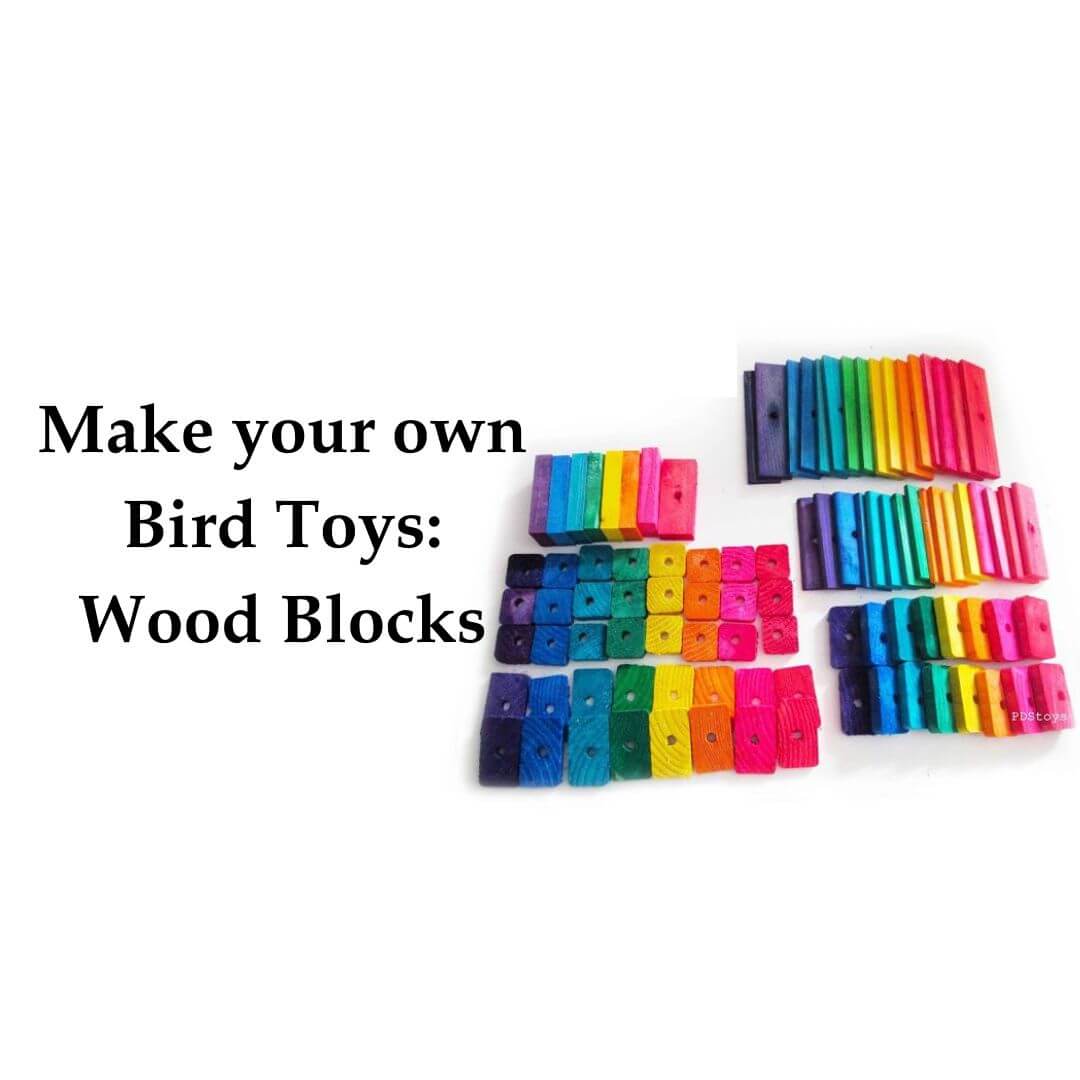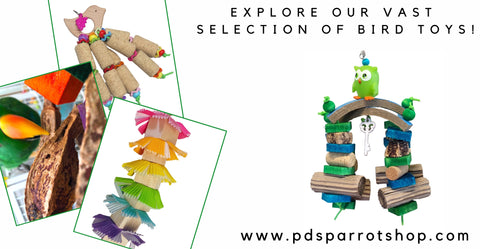
Make your own Bird Toys: Wood Blocks
Welcome to the world of Make your own bird toys: wood blocks edition, where creativity meets nature! If you're a bird enthusiast or simply love crafting, this article is for you. In this comprehensive guide, we'll explore the exciting journey of creating bird wood blocks. These blocks not only add a touch of beauty to your parrot's cage but also serve as a mental challenging bird toy. Let's embark on this exciting DIY adventure and make your own bird wood blocks that both you and the birds will adore. Shop Now: Wood Bird Toys

Pin Me!
Why Make Your Own Bird Toys is Great for Parrots
DIY bird wood blocks are an excellent addition to your parrot’s toy collection for several reasons:
1. Safe and Non-Toxic
When making your own wood blocks, you control the materials, ensuring they are free from harmful chemicals, pesticides, or unsafe dyes. Many store-bought toys contain unknown treatments, but with DIY options, you can select bird-safe wood like pine, maple, or applewood and use natural, non-toxic dyes.
2. Encourages Natural Chewing Behavior
Parrots have an instinct to chew—both to keep their beaks healthy and to satisfy their natural foraging tendencies. Providing safe, chewable wood blocks prevents destructive behaviors like chewing on furniture or cage bars while promoting mental and physical enrichment.
3. Cost-Effective and Customizable
Buying pre-made bird toys can be expensive, but DIY wood blocks are a budget-friendly alternative. You can tailor the size, shape, and colors to your bird’s preferences, making the perfect toy for small, medium, or large parrots.
4. Provides Enrichment and Mental Stimulation
Birds thrive on variety and mental engagement. DIY wood blocks can be incorporated into different toys—strung on ropes, hidden in foraging setups, or added to play gyms. This variety helps prevent boredom, reducing the risk of behavioral issues like feather plucking or excessive screaming.
5. Strengthens Bonding Through DIY Projects
Making toys for your bird isn’t just fun—it’s a bonding experience! Whether you involve your parrot in the process (letting them inspect materials) or surprise them with a new homemade toy, it reinforces trust and engagement.
How to Make Our Own Bird Toys: Wood Blocks (Step-by-Step Guide)
You need to buy untreated pine wood from your local lumber yard. Pinewood is a soft white wood that Home Depot and Lowes carry in different sizes. Most parrots love this wood because they can easily chew it into toothpicks.
Before you head towards the lumber yard, bring gloves and a pocket knife. Gloves to prevent splinters. Knife to open new bundles of lumber.
There are a few different sizes.
1 by 2
2 by 2
1 by 3
If you need something larger, you can go for the 2 by 3 and 2 by 4. Those are usually Fir, which is still safe, but harder. Great for Macaws, Cockatoos.
When purchasing lumber you want straight pieces with minimal knots. I know knots make it look cool, but for our purpose, no knots.
You always want to look at the color of the wood. Make sure there's no discoloration, which can be a sign of mold. If you're unsure, leave it, and find another piece.
Your lumber pieces shouldn't have any sap or stickiness. If it does, it's no good.
For perfect pieces of parrot wood blocks, make sure your lumber has all corners, throughout the whole length. Yes, I spend a good time at the lumber yard, inspecting every piece of lumber I buy.
Cutting Your our own Bird Blocks
Now it's time to make your own bird toys with wood blocks by cutting your lumber. Using a saw, carefully cut your wood blocks into the desired shapes.
You can cut them into any thickness, length, or width depending on the lumber size.
Sometimes your cuts will depend on your toy designs but most times it will depend on your parrots. Most parrots like nothing thicker than 3/4 inch. Wood chippers can take down a 4 by 4 by 4 wood block. Small parrots will like thinner pieces, up to 1/8th of an inch.
Make Your Own Bird Toys: Drilling Holes for Toy Assembly
Hand drill with 3/8th in drill bit is good enough for wood pieces. For larger wood blocks, a larger hole will be needed for the larger chain or thicker rope. If you are doing more than a few blocks, a drill press is highly recommended.
If you don't wish to cut and drill wood blocks, www.pdsparrotshop.com have wood block kits, ready to turn into parrot toys.
Coloring with Non-Toxic Dyes
Now the real fun begins when you make your own bird toys by dyeing parrot wood blocks with different colors. We dye ours outside, with lots of room mostly because I'm messier than any parrot.
Use food coloring: Wilton, Americolor, or any other human grade-food color. You will also need 70% isopropyl alcohol.
Side note: isopropyl Alcohol will not be consumed by the parrot. During the drying stage, the alcohol will evaporate. I use isopropyl alcohol because I find it easier to use, and it disinfects the blocks.
Mix 1:15 ratio of color: isopropyl alcohol. With gels, you might need to work it a bit more. The ratio can be changed to personal preference. But 1:15 is a good place to start.
Pour your color in a bucket and then submerge your wood blocks, take them out, and dry them on wire or newspaper. I use the same dye for all my wood, vine items, and coffee filters.
After a few days of cutting, drilling, bleeding, dyeing the kitchen floor, you have completed making your own bird wood blocks.
More Articles on DIY Bird Toys
Complete guide to DIY wood perches for birds.
DIY Bird Toys: Fun and Enriching Toys for your Parrot
Author: Monika Sangar
Co-founder of Prego Dalliance Sanctuary, Artisan of PDS Parrot Shop
Monika Sangar is a parrot rescuer, bird food chef, and toy designer with over a decade of experience in avian care and nutrition. She is the founder of Prego Dalliance Sanctuary and the author of The Science of Avian Nutrition, a cookbook dedicated to fresh, healthy meals for parrots. Explore more bird care tips and bird toys at PDS Parrot Shop!


3 comments
Monica is so generous & helpful with her time & talents in toy making, tips, food etc.. basically everything that benefits the birds! She is a wonderful soul, & has been very much appreciated by me & our flock! Thank you so much for sharing your experience, knowledge & skills☺️
Thank you for this info. I always wonder about a lot of thing in your article. Greatly Appreciated.
How great is this!!!! I never thought about it until now! Thank you so much for the information!!!!!